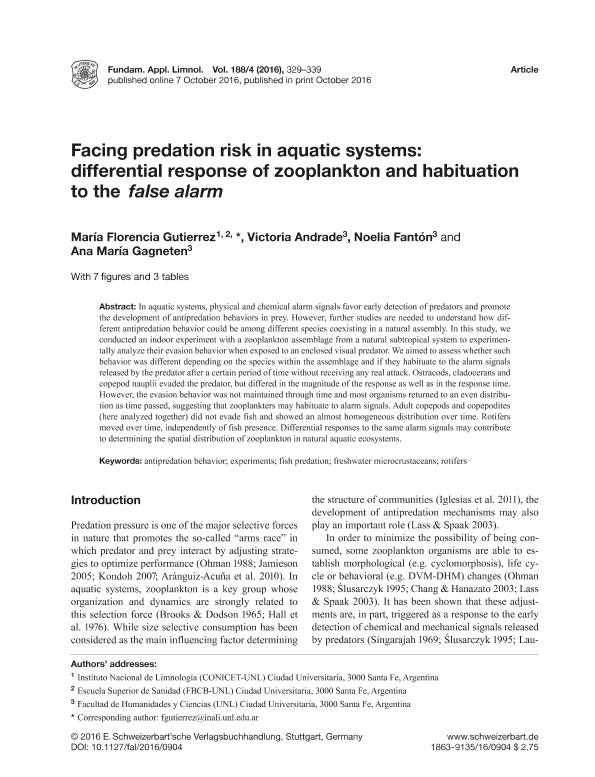Artículo
Facing predation risk in aquatic systems: Differential response of zooplankton and habituation to the false alarm
Gutierrez, Marìa Florencia ; Andrade, Victoria Soledad
; Andrade, Victoria Soledad ; Fantón, Noelia Isabel
; Fantón, Noelia Isabel ; Gagneten, Ana María
; Gagneten, Ana María
 ; Andrade, Victoria Soledad
; Andrade, Victoria Soledad ; Fantón, Noelia Isabel
; Fantón, Noelia Isabel ; Gagneten, Ana María
; Gagneten, Ana María
Fecha de publicación:
11/2016
Editorial:
E Schweizerbartsche Verlags
Revista:
Fundamental and Applied Limnology
ISSN:
1863-9135
Idioma:
Inglés
Tipo de recurso:
Artículo publicado
Clasificación temática:
Resumen
In aquatic systems, physical and chemical alarm signals favor early detection of predators and promote the development of antipredation behaviors in prey. However, further studies are needed to understand how different antipredation behavior could be among different species coexisting in a natural assembly. In this study, we conducted an indoor experiment with a zooplankton assemblage from a natural subtropical system to experimentally analyze their evasion behavior when exposed to an enclosed visual predator. We aimed to assess whether such behavior was different depending on the species within the assemblage and if they habituate to the alarm signals released by the predator after a certain period of time without receiving any real attack. Ostracods, cladocerans and copepod nauplii evaded the predator, but differed in the magnitude of the response as well as in the response time. However, the evasion behavior was not maintained through time and most organisms returned to an even distribution as time passed, suggesting that zooplankters may habituate to alarm signals. Adult copepods and copepodites (here analyzed together) did not evade fish and showed an almost homogeneous distribution over time. Rotifers moved over time, independently of fish presence. Differential responses to the same alarm signals may contribute to determining the spatial distribution of zooplankton in natural aquatic ecosystems.
Archivos asociados
Licencia
Identificadores
Colecciones
Articulos(INALI)
Articulos de INST.NAC.DE LIMNOLOGIA (I)
Articulos de INST.NAC.DE LIMNOLOGIA (I)
Citación
Gutierrez, Marìa Florencia; Andrade, Victoria Soledad; Fantón, Noelia Isabel; Gagneten, Ana María; Facing predation risk in aquatic systems: Differential response of zooplankton and habituation to the false alarm; E Schweizerbartsche Verlags; Fundamental and Applied Limnology; 188; 4; 11-2016; 329-339
Compartir
Altmétricas



